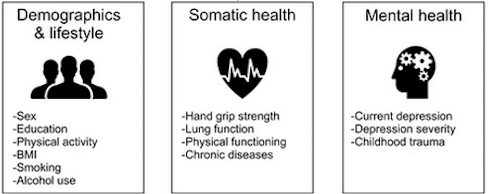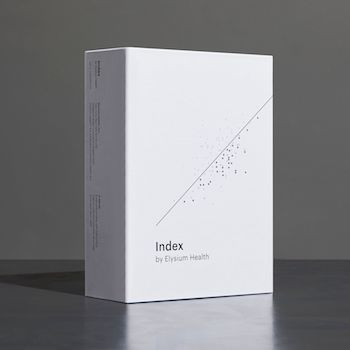Five Biological Age Tests That Predict Your Real Age

Many of us are interested in biological age tests because we know that people age at different rates — some are biologically younger than their chronological years, and others are older — and we wonder, Is my body younger or older than my calendar age?”
Yes, oftentimes there’s a difference between biological and chronological age. My favorite example of that is embodied in the late Jack LaLane. He died at 96, and yet up to the year prior to his death, Jack was still doing his daily workout routine. I don’t know how much younger Jack was biologically than his actual years on the planet, but how many 95 year-olds do you know that exercise vigorously every day?
As I detail in Four Masters Who Defy Age, there are many other examples of senior citizens that are evidently younger than their years. Perhaps you are as well.
Wouldn’t you like to know?
Five Biological Age Tests
Aging can be conceptualized in several different ways. Of course, you know about chronological age measured by date of birth. Biological age is, however, somewhat untethered from date of birth in that it may be younger or older than birth date.
This can be complicated stuff, so I want to summarize and explain the findings of a research article reviewing the latest science on determining biological age published on February 9, 2021 in eLife Sciences.
We’ll touch on:
- Five biological age tests
- Why not all five are equal or agree
- Factors common to all five bioage tests
- Two bioage tests you can take now
While chronological age is measured by date of birth, biological age reflects the relative aging of an individual’s physiological condition as measured by various physiological and cellular indices.
There are five commonly used indices to determine biological age.
1. Telomere length
A measure of specific DNA–protein structures found at both ends of each chromosome, telomeres protect ![]()
![]() the genome from nucleolytic degradation, unnecessary recombination, repair, and interchromosomal fusion. Telomeres therefore play a vital role in preserving the information in our genome. (A genome is all the genetic material of an organism.)
the genome from nucleolytic degradation, unnecessary recombination, repair, and interchromosomal fusion. Telomeres therefore play a vital role in preserving the information in our genome. (A genome is all the genetic material of an organism.)
Telomere length has been extensively researched, and was found to be shorter in various physiological (somatic) conditions, all-cause mortality and a range of psychiatric disorders.
2. DNA methylation patterns (epigenetic age)
One of the main epigenetic modifications, DNA methylation controls gene expression through altering chromosomal structure, DNA conformation, DNA stability and the functional relationship between DNA and protein.
Advanced epigenetic aging has been linked to worse somatic health, mortality, depressive disorder, and post-traumatic stress disorder.
3. Variation in transcription (transcriptome age)
In order for the gene “instructions” in DNA to be “read” and carried out, they need to be transcribed, or copied, into RNA — these gene readouts are called “transcripts”, and a transcriptome is a collection of all the gene readouts present in a cell. Many physiological and cognitive factors associated with aging alter the fidelity of transcription.
Advanced transcriptomic aging was found in those with higher blood pressure, cholesterol levels, fasting glucose, and body mass index (BMI).
4. Alterations in the metabolome (metabolomic age)
For cells to normally function, grow and be maintained, they must produce a certain collection of metabolites (“low molecular weight metabolites”). The metabolome is the result of the associated biochemical reactions, and determines the biological structure and function of the final physical appearance (phenotype) of an organism.
Advanced metabolomic aging increases risk of future cardiovascular disease, mortality, and functionality.
5. Alterations in proteome (proteomic age)
Proteins are large, complex molecules that do most of the work in cells and are required for the structure, function, and regulation of the body’s tissues and organs. A proteome is the complete set of proteins expressed by an organism, and as such is the expression of an organism’s genome.
The term can also be used to describe the assortment of proteins produced at a specific time in a particular cell or tissue type. The proteome is an expression of an organism’s genome. However, in contrast with the genome, which is characterized by its stability, the proteome actively changes in response to various factors, including the organism’s developmental stage and both internal and external conditions.
Among the many age-related indices associated with the proteome are proteins associated with inflammation, immune response and cell death.
Irrespective of the type of bioage test used to determine biological age, what they all do is to measure indices associated with a test relative to some predetermined norm. So, using telomere length as an example, scientists know what average telomeres length would be for, say, a 60-year old, and therefore could ascertain if those tested for any particular 60 year-old are longer or shorter than the norm.
Why is this important?
Well, as you might imagine, advanced biological aging has been associated with poor somatic health, including the onset of aging-related somatic diseases like cardiovascular disease, diabetes, and cognitive decline.
Not All Biological Age Tests are Equal or Agree
While all biological age tests aim to measure the biological aging process, there is limited evidence for cross-correlations among different bioage tests, often referred to as “aging clocks”.
Ideally, each testing method would come up with a similar biological age for any individual, but that only appears to be the case among certain tests, according to the eLife Science research paper, which asserts:
- There is low agreement between eleven quantifications of biological aging including telomere length, epigenetic aging, and biomarker-composites.
- There are relatively strong correlations between three physiological composite biological clocks that involve homeostatic dysregulation (), but not with telomere length.
- Some studies show that telomere length was not correlated with epigenetic aging.
- Epigenetic clocks show modest correlations to a transcriptomic clock.
Given that it’s unlikely a single biological clock can fully capture the complexity of the aging process, what’s needed is a composite index that integrates the different biological aging clocks and thereby identifies aging at several molecular levels.
In the meantime, it’s helpful to know which of the available biological age tests are the most accurate, and which ones are available to you to learn how old your body thinks you are.
Factors Common to all Five Bioage Tests
For the five biological aging indicators and the composite clock, associations were computed with a wide panel of lifestyle (e.g. alcohol use, physical activity, smoking), somatic health (functional indicators, BMI, metabolic syndrome, chronic diseases) and mental health (childhood trauma, depression status) determinants.
The eLife Science paper examined lifestyle factors that were meaningful to all five biological aging tests, or clocks, which were:
- Gender (women live longer)
- Smoking (the more you smoke, the faster you age)
- Alcohol use (the more you drink, the faster you age)
- Physical activity (strangely, this wasn’t a significant factor, but don’t stop moving — most studies show a positive correlation between exercise and healthy aging.)
- BMI (the fatter you are, the older, faster, you get)
- Metabolic syndrome (a strong age amplifies)
- Chronic disease (as above)
- Mental health determinants (as above)
Lifestyle Factors
Digging into this a bit, male sex was associated with shorter telomere length and advanced epigenetic, transcriptomic, and metabolomic aging, in line with a large body of literature that shows advanced biological aging and earlier mortality in males compared to females.
High BMI was consistently related to all biological aging indicators, showing that the more overweight or  obese, the higher the biological age, also after controlling for sex. Various studies showed similar associations between high BMI and shorter telomere length, and older epigenetic and transcriptomic aging signatures.
obese, the higher the biological age, also after controlling for sex. Various studies showed similar associations between high BMI and shorter telomere length, and older epigenetic and transcriptomic aging signatures.
That said, I’m compelled to disgorge my pet peeve about BMI, which is that it’s an unhelpful metric for those with more than average muscle mass. As I explain in How Much Should You Weigh, BMI does not account for body weight due to higher than average muscle, so anybody that consistently does resistance training (calisthenics, weight lifting) may have a BMI number that puts him or her in the overweight group, as does my BMI score of 25.
One final comment on lifestyle factors having relevance to the biological age tests is that the analyses showed similarly consistent associations between the prevalence of metabolic syndrome and advanced levels of aging; further, all but epigenetic aging was advanced with respect to cigarette smoking.
Psychological Factors
Major depressive disorder (MDD) status was consistently related to advanced aging in three (epigenetic, transcriptomic, proteomic) out of the five biological aging indicators. In contrast, associations between mental health and biological aging (indicated by telomere length, homeostatic dysregulation) did not show associations between mental health and biological aging. However, the cohort studied here may have been too young to fully develop aging-related manifestations of mental health problems, or lacked age variation.
The Composite Biological Age Test
The eLife Science paper computed a composite index by summing up the five biological aging indicators studied. This composite index demonstrates larger effect sizes for BMI, sex, smoking, depression severity, and metabolic syndrome than the individual aging indicators.
Being biologically old at multiple cellular levels has a cumulative multi-systemic effect. When integrated, the composite index reveals stronger associations with sex, BMI, metabolic syndrome and current MDD.
This provides further support for the hypothesis that not one biological clock sufficiently captures the biological aging process and that not all clocks are under the control of one unitary aging process. There’s much room for further progress to determine if biological aging can be modified by intervening on these determinants.
Two Bioage Tests You Can Take Now
There are several biological age tests on the market that you can buy, but I’m currently only familiar with Index offered by Elysium Health.
Index — “Discover Your Biological Age”
Index is the bioage test made by the makers of the NAD+ precursor, Basis and the cognitive health supplement, Matter.
The Index test gives you:
- Biological Age, a measure of the average age at which your body is expected to function
- Cumulative Rate of Aging, the pace at which your body has aged for every year you’ve been alive
- Science-backed lifestyle recommendations you can use to adopt healthier habits
There’s some very good science behind Index, but the test is costly.
The Horvath Clock Test for Bioage
I’ve written in detail about the Horvath Clock and amended a Google Sheet so that you can input nine blood test markers and get an estimation of your biological age with 80+ percent accuracy.
Know that some people find it difficult to use the spreadsheet, so I found a test you can buy that’s easier to us.provided by agelessRx, but it costs $75 last time I checked.
Your Takeaway
Remember these four things about the eLife Science paper:
- Although the five biological aging indicators share some associations with somatic and mental health, they largely track distinct, but also partially overlapping aspects of the aging process.
- Male sex, smoking, higher BMI and metabolic syndrome were consistently related to advanced aging at multiple biological levels.
- There’s evidence of depression and childhood trauma associations across cellular levels, and sample sizes, highlighting the important link between mental health and biological aging.
- You can test your bioage with various test kits, such as Index, or if you have a specific set of the needed nine blood markers you may either input those metrics in my spreadsheet or in a test offered by agelessRx, both of which are described here.
Last Updated on November 8, 2022 by Joe Garma





